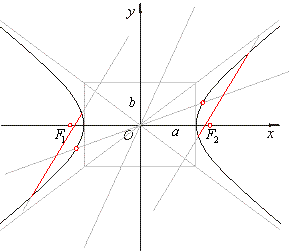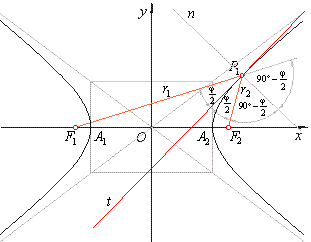|
| Conic
Sections |
|
|
|
|
Hyperbola
and Line
|
 Hyperbola and line relationships Hyperbola and line relationships
|
|
Condition for a line to be the tangent to the hyperbola -
tangency condition |
 The equation of the tangent at the point on the hyperbola
The equation of the tangent at the point on the hyperbola
|
 Polar and pole of the hyperbola
Polar and pole of the hyperbola
|
 Construction of the tangent at the point on the hyperbola
Construction of the tangent at the point on the hyperbola
|
|
|
|
|
|
|
| Hyperbola and line relationships
|
| Let examine relationships between a hyperbola and a line passing through the center of the hyperbola, i.e., the
origin. A line y =
mx intersects the hyperbola at two
points if
|
|
the slope |m|
<
b/a but
if |m|
> b/a
then,
|
|
the line y =
mx does not intersect the hyperbola at all.
|
| The diameters of a hyperbola are straight lines
passing through its center.
|
|
The asymptotes divide these two pencils of diameters
into, one which intersects the curve at two points, and
the
other which do not intersect.
|
A diameter of a conic section is a line which passes
through the midpoints of parallel chords.
|
Conjugate diameters of the hyperbola (or the ellipse)
are two diameters such that each bisects all chords
drawn parallel to the other.
|
|
 |
|
| As the equation of a hyperbola can be obtained from the equation of an ellipse by changing the sign of
b2
|
|
that is, a2(1
-
e2)
= -a2(e2
-
1) =
-b2, |
| this way, we can use other formulas relating to the ellipse to obtain corresponding
formulas for the hyperbola. |
| Therefore, when we examine conditions which determine position of a line in relation to a hyperbola that is, |
| when
solve the system of
equations,
y =
mx + c |
| b2x2
-
a2y2
= a2b2
|
| |
|
then if, a2m2
-
b2
> c2
the line intersects the hyperbola at two points,
|
|
a2m2
-
b2 = c2
the line is the tangent of the hyperbola,
|
|
a2m2
-
b2
< c2
the line and the hyperbola do not intersect. |
|
| Condition for a line to be the tangent to the hyperbola -
tangency condition
|
| A line is the tangent to the hyperbola if
|
a2m2
-
b2 = c2. |
|
|
| Regarding
the asymptotes, to which c
= 0, this condition gives
|m|
= b/a
and that is way we can say that the hyperbola touches the asymptotes at infinity. |
| From the tangency condition it also follows that the slopes of the tangents
will satisfy the condition, |
|
|
| That is, the tangents to the hyperbola can only be parallel to a line belonging to the pencil of lines that do not
intersects the hyperbola. |
|
| The equation of the tangent at the point on the hyperbola
|
As we already mentioned, the points of contact of a line and the hyperbola can be obtained from the
corresponding formula for the ellipse by changing b2
with -b2
thus |
|
 |
the
tangency point or the point of contact. |
|
| So, the intercept and slope of the
tangent |
 |
|
| or |
b2x1x
-
a2y1y
= a2b2 |
the equation of the tangent at a point
P1(x1,
y1)
on the hyperbola.
|
|
|
| Polar and pole of the hyperbola
|
If from a point
A(x0, y0), exterior to the hyperbola, drawn are tangents, then the secant line passing through
the contact points, is the polar of the point A.
The point A
is called the pole of the polar. |
| The equation of the
polar is derived the same way as for the ellipse, |
| |
b2x0x
-
a2y0y
= a2b2 |
the equation of the
polar of the point A(x0, y0). |
|
|
| Construction of the tangent at the point on the hyperbola
|
| The tangent at the point
P1(x1,
y1)
on the hyperbola is the bisector of the angle F1P1F2
subtended by focal |
|
radii,
r1
and
r2 at
P1 .
|
|
The proof shown for the ellipse applied to
the hyperbola gives,
|

|
| or |
 |
|
|
|
See the title
'
The angle between the focal radii at a point of the
ellipse'.
|
|
 |
|
|
|
|
|
|
|
|
|
|
|
|
| College
algebra contents E |
|
 |
|
| Copyright
© 2004 - 2020, Nabla Ltd. All rights reserved. |